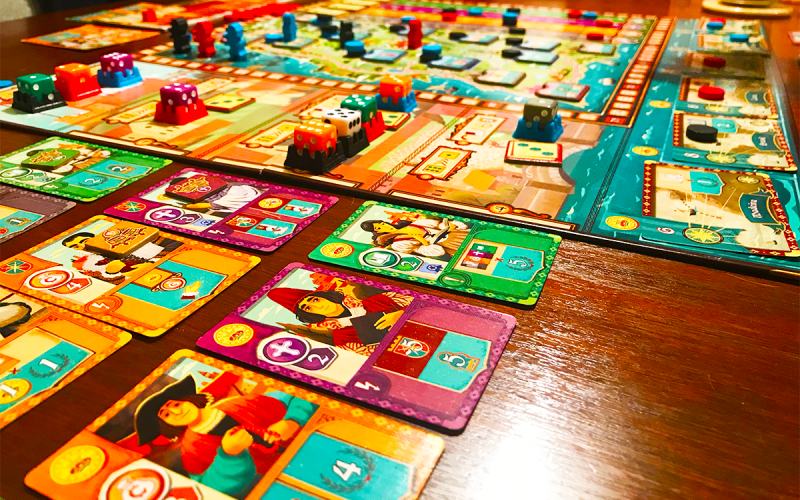This game review was originally published in Tumbleweird, December 2018.
Let me start out by saying that Coimbra is the kind of gateway game not often talked about: it’s a gateway between medium-weight hobby games and deeper, more abstract and strategic Euro games. If you’ve played Ticket to Ride or Catan to death and you’re looking for something a little meatier to bring to the table, Coimbra is an excellent game to provide this.
According to the game’s description: “In the 15th and 16th century, Portugal is thriving under its leading role during the Age of Discovery. Nestled in the heart of Portugal, the city of Coimbra serves as a cultural center of the country. As the head of one of Coimbra‘s oldest houses, you seek to earn prestige by deepening relationships with nearby monasteries or funding expeditions of the era.” You can just throw that out the window right now. Like in many Euros, theme is just a loose piece of tissue paper wrapped around a massive series of heavy, weighty mechanisms. Coimbra is no different.
Coimbra is about scoring points. You can do this in several extremely different ways, and you’ll be encouraged to use multiple strategies throughout the game to pull it off rather than focusing all of your efforts toward a single path.
The core mechanic of the game is a dice draft where players roll an amount of dice, and then take turns choosing a single die for its color and value. This choice then permits players to either gain influence from a faceless king or gain the favor of a member of society and bring them into your tableau. The draft itself has a lovely little component mechanic where you’ll be taking a die and resting it in a little plastic rampart-looking base of your color.
Placing dice triggers various actions that require far more description than this review will allow. Here’s a sampling: There are four tracks that players will advance on permitting more significant income values; these incomes return gold, guards (another currency), or victory points, or permit pilgrim movement. For the pilgrim movement, there’s a big map in the center of the board consisting of randomly selected monasteries, each of which provide entirely unique benefits. There are voyages that you’ll be able to invest in that will score you some game-end victory points, again in completely unique ways. Remember the society members you pull into your tableau? Yeah, they’ll trigger things either immediately, at a particular phase, or at the end of the game.
Coimbra is spectacular, and it’s gorgeous. The components are colorful, and as the game is played it’s pretty remarkable what a bunch of wooden hockey pucks can do to transform a board covered in iconography. It’s the kind of game where you should go in expecting to throw away the first few plays just to get the hang of it, but it’s so incredibly rewarding once you catch on. Definitely one of my top games this year.
Designed by: Flaminia Brasini, Virginio Gigli
Player Count: 2-4
Playtime: 60-90 minutes
Time to Learn: 15 minutes
Complexity: 3.5/5
Replayability: 4.5/5
MSRP: $70
Will my mom play it?: Nope nope nope nope.
I purchased this game from Adventures Underground because they’re awesome.
Written by Brendan Quinn; President of Tri-City Area Gaming. Learn more about the 200+ annual gaming events we host by visiting http://www.tricityareagaming.com.

